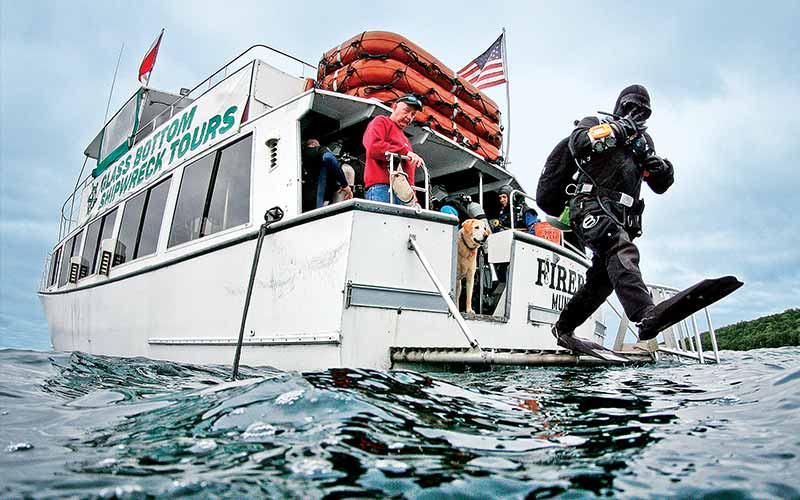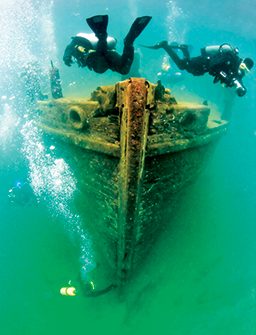It’s disheartening to see the boat’s dive flag blowing stiffly in a northwest wind — not a good sign when you’re about to dive Lake Superior. But a quick check with Capt. Peter Lindquist of Shipwreck Tours allays my fears. We’ll adjust the schedule and dive the portion of the Alger Underwater Preserve that is tucked safely in the confines of Murray Bay behind Grand Island. Problem solved.
Almost anywhere else in the Great Lakes we’d be shorebound for the day, but the sheltered waters of the preserve make diving here a sure thing in all but the worst weather. Better still, the preserve happens to be home to a fleet of seven great wrecks that both novice and advanced divers can enjoy.

Our first dive, the Bermuda, is a camera-friendly, two-masted schooner that sank in Munising Bay during a storm in 1870. It was raised in 1883 and towed to Murray Bay, where it sank again in just 25 feet of water. Protected by the bay from the weather and the ravages of winter ice, the wooden ship retains its classic lines. Bonus: At this depth, there is plenty of time to photograph every foot of this well-preserved beauty. A large wooden rudder, cargo hatches and a workmanlike bow accentuate this ship, one of the most visited sites in all the Great Lakes.
What the Bermuda is for photographers, the Manhattan is for those who love the details of how historic wrecks were put together. The wooden steamer ran aground near the south end of Grand Island in 1903 and burned to the water line. Located just a stone’s throw from land, the broken remains rest in 40 feet of water, but most of the structure can be explored at a depth of 25 feet.
We enjoy a leisurely trip around the wreck site, stopping to examine the large rudder and rudder post and counting the neat rows of steel pins protruding from the ship’s timbers. While the wreck is not intact, this dive is particularly interesting to maritime history buffs precisely because of all the bits and pieces strewn about. Think of a dive on the Manhattan as a dive through an exploded-view drawing of a wooden steamship.

Shortly after the last diver is back on deck, Capt. Lindquist repositions the boat in another secluded Grand Island cove, and then he fires up the gas grill for the traditional cookout that is included with Saturday afternoon charters. Bratwursts, pasta salad, vegetables and homemade cookies combined with the beauty of the cove and stories of the day’s dives make this the ultimate “Up North” dive experience.
The following day brings a return to calm weather, allowing us to dive the deepest known wreck in the Alger Underwater Preserve, the Smith Moore. The 260-foot wooden steam barge went down in the Munising East Channel on July 13, 1889, the result of a collision in open water. The wreck sits upright and mostly intact at 105 feet, and our dive starts near the stern. Working our way toward the bow, we swim past a large boiler and engine, deck winch and broken mast with an intact fife rail. Shifting sands continually cover and uncover parts of the wreck, making each visit a unique experience.
Our final dive of the trip is the Steven M. Selvick, a tugboat intentionally sunk as a dive site on June 1, 1996. The wreck lies on its port side in about 60 feet of water atop a rocky patch of lake bottom. As we make our descent, the stern deck comes into view, hiding the large intact propeller.
At 70 feet in length, the tugboat is easy to circumnavigate on a leisurely dive. Swimming a clockwise route, one can peer into the engine room before swimming past the tow bit on the stern deck and onward toward the pilothouse. Careful divers can slip into the small pilothouse from the front and out a door on the starboard side, continuing their swim around the wreck. Photographers may want to skip the leisurely tour and head straight for starboard side and the stunning view of the intact prop framed by the ship’s hull and the surrounding water.
How To Dive It
The Alger Underwater Preserve is a six-and-a-half-hour drive from Detroit and a seven-hour drive from Chicago. There is one charter operator in Munising with an air fill station. If you want to dive nitrox, you must bring your own. The Alger Underwater Preserve is one of Michigan’s 12 designated shipwreck preserves. Removing artifacts or disturbing wrecks is a felony punishable by two years in prison, stiff fines and confiscation of boats, cars and dive gear.
Conditions: Visibility at Alger Underwater Preserve can range from 25 to 50-plus feet depending on weather and the time of year. Lake Superior is the coldest of the five Great Lakes. Surface temperatures in the summer may hit the low 60s°F; count on bottom temperatures in the 40s°F. Drysuits are highly recommended. The diving season usually runs between May and October; you will need to book commercial dive charters in advance.
Getting There: From Detroit: Take I-75 north across the Mackinac Bridge. Travel west on US-2, north on MI-77 and west on MI-28. From Chicago: Take I-94 west into Wisconsin. Travel I-43 north to I-41 north. Follow MI-35 N, which becomes US-2 E/US-41 N. Turn left onto US-41, and then make a sharp right onto MI-67.Turn right on MI-94 and then left onto MI-28 into Munising.
Dive Operators: Shipwreck Tours, 906-387-4477.
© Alert Diver — Q2 Spring 2010